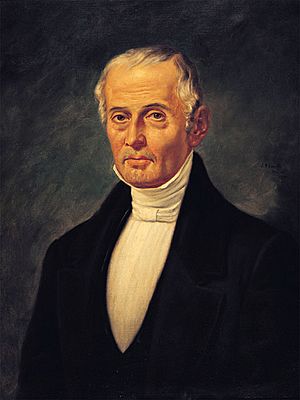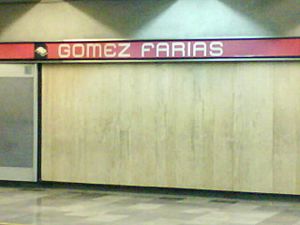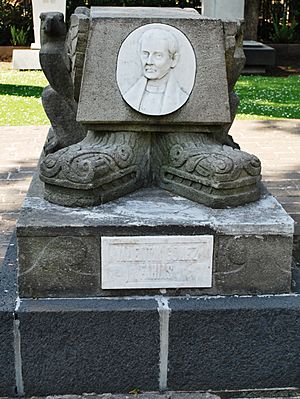Valentín Gómez Farías facts for kids
Quick facts for kids
Valentín Gómez Farías
|
|||||||||||||||
|---|---|---|---|---|---|---|---|---|---|---|---|---|---|---|---|
 |
|||||||||||||||
| 7th President of Mexico | |||||||||||||||
| In office 1 April 1833 – 16 May 1833 |
|||||||||||||||
| Vice President | Himself | ||||||||||||||
| Preceded by | Manuel Gómez Pedraza | ||||||||||||||
| Succeeded by | Antonio López de Santa Anna | ||||||||||||||
| In office 3 June 1833 – 18 June 1833 |
|||||||||||||||
| Vice President | Himself | ||||||||||||||
| Preceded by | Antonio López de Santa Anna | ||||||||||||||
| Succeeded by | Antonio López de Santa Anna | ||||||||||||||
| In office 5 July 1833 – 27 October 1833 |
|||||||||||||||
| Vice President | Himself | ||||||||||||||
| Preceded by | Antonio López de Santa Anna | ||||||||||||||
| Succeeded by | Antonio López de Santa Anna | ||||||||||||||
| In office 16 December 1833 – 24 April 1834 |
|||||||||||||||
| Vice President | Himself | ||||||||||||||
| Preceded by | Antonio López de Santa Anna | ||||||||||||||
| Succeeded by | Antonio López de Santa Anna | ||||||||||||||
| In office 23 December 1846 – 21 March 1847 |
|||||||||||||||
| Vice President | Himself | ||||||||||||||
| Preceded by | José Mariano Salas | ||||||||||||||
| Succeeded by | Antonio López de Santa Anna | ||||||||||||||
| Vice President of Mexico | |||||||||||||||
| In office 1 April 1833 – 26 January 1835 |
|||||||||||||||
| Vice President | Himself (3 times) Antonio López de Santa Anna (3 times) |
||||||||||||||
| Preceded by | Anastasio Bustamante | ||||||||||||||
| Succeeded by | Nicolás Bravo | ||||||||||||||
| In office 23 December 1846 – 1 April 1847 |
|||||||||||||||
| Vice President | Himself Antonio López de Santa Anna |
||||||||||||||
| Preceded by | Nicolás Bravo | ||||||||||||||
| Succeeded by | Ramón Corral | ||||||||||||||
| President of the Senate of Mexico | |||||||||||||||
| In office 1 January 1825 – 31 January 1825 |
|||||||||||||||
| Preceded by | Office established | ||||||||||||||
| Succeeded by | Simón de la Garza | ||||||||||||||
|
|||||||||||||||
| Personal details | |||||||||||||||
| Born | 14 February 1781 Guadalajara, New Kingdom of Galicia, New Spain (now Jalisco, Mexico) |
||||||||||||||
| Died | 5 July 1858 (aged 77) Mexico City, Mexico |
||||||||||||||
| Political party | Liberal | ||||||||||||||
| Spouse |
Isabel López
(m. 1817; died 1858) |
||||||||||||||
| Alma mater | Royal University of Guadalajara | ||||||||||||||
| Signature | |||||||||||||||
Valentín Gómez Farías ( 14 February 1781 – 5 July 1858) was the President of Mexico during two main periods: one in the early 1830s and one in the late 1840s, when he served as president during the Mexican-American War. In his first term, he enacted significant liberal reforms that were aimed at undermining the power of the Roman Catholic Church and the army in Mexico.
Biography
José Valentín was the son of the rich Spanish merchant José Antonio Lugardo Gómez de la Vara y Ramírez, and María Josefa Martínez de Farías y Núñez de Villavicencio, an aristocratic criolla from Saltillo.
He was trained as a medical doctor and was one of the most important liberal politicians figures in early independent Mexico. In the immediate aftermath of Mexican independence in 1821, Gómez Farías had initially supported Agustín de Iturbide as constitutional monarch of Mexico, but withdrew his support when Iturbide abolished the new congress of Mexico. After Iturbide's abdication, Gómez Farías was active in the congress of the Republic of Mexico, established in 1824. He emerged as a leader of the radical liberals (puros) and allied with General Antonio López de Santa Anna. The first presidency of Santa Anna from 1833 to 1836 was a temporary victory for the Mexican Liberals and Gómez Farías; Santa Anna preferred simply holding the title of president rather than actually serving as president. With President Santa Anna residing at his estate in Veracruz and uninterested in administering his government, the actual executive duties fell to Vice-President Gómez Farías, who used this power to sponsor liberal reforms, specifically targeting the army and the Roman Catholic Church. He abolished the special privileges of the Church and army (fueros), which allowed them to be tried in separate courts; secularized education which had been in the hands of the clergy; and sought to undermine the Church's economic power. Gómez Farías also sought to extend these reforms to the frontier province of Alta California. He promoted legislation to secularize the Franciscan missions there, and in 1833 organized the Híjar-Padrés colony to bolster non-mission settlement. A secondary goal of the colony was to help defend Alta California against perceived Russian colonial ambitions from the trading post at Fort Ross.
Hoping to prevent future coups and to limit the political influence of the Mexican Army, the Gómez Farías administration reduced the size of the military and abolished the fueros (privileges) that excluded military officers from civil trials and laws.
Following the reform models of the Bourbon monarchs a century earlier, Gómez Farías sought to limit the political and economic privileges of the clergy. Initially, the Goméz Farías administration advised Catholic clerics to limit their sermons to religious concerns and stop intervening in politics. Following this, Farías along with his principal advisors, the moderate Liberal José María Luis Mora and the radical Liberal Lorenzo de Zavala, pressured the Mexican Congress to pass a series of measures. The first of these was to secularize Mexican education. The University of Mexico, its faculty consisting primarily of priests, was closed and reorganized. With these educational reforms, the new secular schools organized by the Goméz Farías administration were central to the education and political views of the following generation of Liberals, including the future president Benito Juárez and the reformer Melchor Ocampo. The administration declared that all clerical appointments within Mexico were to be made by the government of the Republic rather than by the papacy.
The Goméz Farías government also enacted additional measures in spite of the disagreement of José María Luis Mora. Ideologically, Zavala and Mora differed on several key issues, such as popular political action and the question of Church wealth. The last measures of the Gómez Farías administration, inspired by Lorenzo Zavala, abolished mandatory tithes and seized Church property and funds. The Conservatives, the Church, and the Army quickly responded in the form of the Revolt of the Polkos, calling for the removal of the Liberal government.
With these sweeping reforms, "Santa Anna kept himself informed and cleverly kept his a distance, attending to which way wind was blowing." Conservative opponents to these radical reforms engineered Gómez Farías' ouster and political exile until the turbulence of the 1840s brought him back into the political sphere. Denouncing the Vice-President and his administration, Santa Anna removed the Republic's leaders, a practice he would continue until the 1850s.
Santa Anna formed a new Conservative, Catholic, and Centralist government, forcing Gómez Farías and many of his supporters to flee Mexico for the United States. The new presidency's first actions abolished the Constitution of 1824, rescinded the Liberal reforms enacted by Gómez Farías, and created a new constitution.
Santa Anna wrote to Mexico City saying that he no longer wanted to be president of Mexico, but to use his military experience to fight off the foreign invasion of Mexico. While he dealt with the issues of presidency, Santa Anna was also secretly dealing with representatives from the United States during the Mexican–American War. Gómez Farías stepped in to become president of Mexico during the war, but was overthrown in the midst of the fighting by Santa Anna.
See also
 In Spanish: Valentín Gómez Farías para niños
In Spanish: Valentín Gómez Farías para niños



